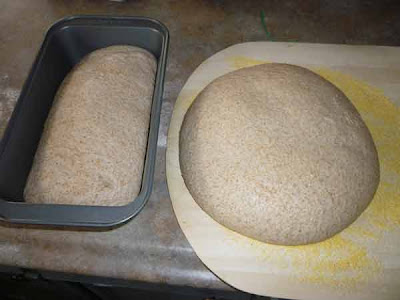In preparation for this experiment, I had a look at what Reinhart was doing with his various pre-ferments. I needed to compare some of the ingredients from his various mixtures to find one that I might be able to use. I was looking here strictly at hydration, flour, and leaven (not so much interested in other ingredients like diastatic malt or salt, etc. at this time). So I made up a little table, and scaled everything to 1 cup of flour (128 g) to see how they compare. All numbers in the table are in grams:
| Firm Starter | 113 'barm' | 28-57 water |
| Mash | 0 yeast | 300 water |
| Biga | 45 'barm' | 108 water |
| Poolish | 34 yeast | 136 water |
| Pate Fermentee | 1 yeast | 377-439 water |
Now, what I thought I wanted would be something similar to his 'Firm Starter' from his first book, The Bread Baker's Apprentice. So I made up a single cup version of the firm starter using the wild yeast, and left it out on the counter to ferment. There wasn't much hydration in it, and it was slow to rise. But rise it did! After about 8 hours out, I put it into the fridge. On baking day, I brought it out to warm up while I went to yoga class.
I measured how much dough I had before mixing them together. I had 836 g of the 5/min day dough, and I had 97 g of the firm starter. I mixed it all together by hand, and kneaded it on the counter, incorporating a fair bit of whole wheat flour as I kneaded. The gluten in the dough developed quite nicely, and I could tell that the thing would hold together better on a pizza peal.
I decided to let it rise like an ordinary dough, then cut it and shape it and proof it again.
The dough doubled in less than an hour, but I gave it a full 60-70 minutes.
Then I shaped the dough as I did the other day, one for a pan and one for the pizza peel. Since the dough is not so wet, I'm hopeful that this boule will not stick to the peel, but will slide onto the hot stone nicely using the cornmeal. The big question is, since it's been out for an hour already, does it really need to proof another 90 minutes, or is another hour good enough? I am going to try to wait for an hour, then pre-heat the oven a full 30 minutes this time, even though its already been out an hour.
Note that this dough has mostly wild yeasts, but not all wild yeast. There is 1/2 a cup of wild yeast starter in the 5min/day dough, and 2/3 cup of it in the firm starter. The commercial yeast did its job of raising the original 5min/day dough, and the glutathione that it left when they died should be no trouble for the wild yeast this time. At least, that's the theory.
I don't know if you can see it or not, but just before putting this in the oven, after 90 minutes of proofing, the boule has a tiny area where the gluten cloak actually pulled apart. It has also settled a bit, so the dough is still quite wet. The dough in the pan has risen a bit.
My wife walked in the front door just as I was taking this bread from the oven, and she said it smelled great: "like honey". Note that, unlike Reinhart's bread, there is no honey in these loaves. But they do have a nice honey-coloured crust.
This time I remembered to score the loaves, and they filled in nicely. I didn't see the popcorn explosion, and I still didn't see all that much oven spring.
The crumb was definitely denser than the one from the other day, but it didn't spread while it sat out, it held its shape. I think that the crust is superior, but I can't say that the taste is any better. I mean, it tastes better than any store-bought whole wheat I've had, but it isn't better than the one from Everyday Bread #2. It toasts up nicely though
Here is a side-by-side comparison of the crumb density. The bread on top is the bread from 'Everyday Bread #2'. See how the newer loaf on the bottom held its shape better?
Notes to myself:
- Find the balance between wet dough and firm dough when you incorporate them.
- Let the wild yeast take its full time to leaven the dough.
- Don't overproof - let the gluten determine when the proofing is done.















No comments:
Post a Comment